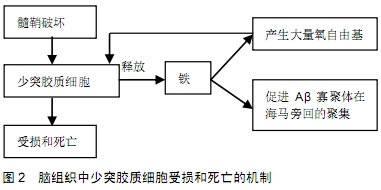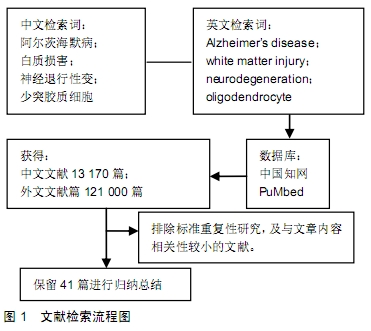[1] WANG SS, ZHANG Z, ZHU TB, et al. Myelin injury in the central nervous system and Alzheimer’s disease. Brain Res Bull. 2018;140:162-168.
[2] ROHER AE, WEISS N, KOKJOHN TA, et al.Increased a beta peptides and reduced cholesterol and myelin proteins characterize white matter degeneration in Alzheimer's disease. Biochemistry.2002;41(37):11080-11090.
[3] FISCHER FU, WOLF D, SCHEURICH A, et al.Altered whole-brain white matter networks in preclinical Alzheimer's disease. Neuroimage Clin. 2015;8:660-666.
[4] TANAKA F ,KACHI T, YAMADA T, et al.Auditory and visual event-related potentials and flash visual evoked potentialsin Alzheimer’s disease: correlations with Mini-Mental State Examinationand Raven’s Coloured Progressive Matrices.J Neurol Sci.1998;156(1):83-88.
[5] KAO YH, CHOU MC, CHEN CH, et al.White Matter Changes in Patients with Alzheimer's Disease and Associated Factors. J Clin Med. 2019;8(2):pii: E167.
[6] TOSTO G, ZIMMERMAN ME, HAMILTON JL, et al.The effect of white matter hyperintensities on neurodegeneration in mild cognitive impairment. Alzheimers Dement.2015;11(12): 1510-1519.
[7] PAK K, CHAN SL, MATTSON MP. Presenilin-1 mutation sensitizes oligodendrocytes to glutamate and amyloid toxicities, and exacerbates white matter damage and memory impairment in mice.Neuro Molecular Med.2003;3(1):53-64.
[8] DESAI MK, MASTRANGELO MA, RYAN DA, et al. Early oligodendrocyte/myelin pathology in Alzheimer's disease mice constitutes a novel therapeutic target.Am J Pathol. 2010; 177(3):1422-1435.
[9] BEHRENDT G, BAER K, BUFFO A, et al. Dynamic changes in myelin aberrations and oligodendrocyte generation in chronic amyloidosis in mice and men.Glia.2013;61(2): 273-286.
[10] DONG YX, ZHANG HY, LI HY, et al .Association between Alzheimer’s disease pathogenesis and early demyelination and oligodendrocyte dysfunction. Neural Regen Res.2018; 13(5):908-914.
[11] NIELSEN HM, EK D, AVDIC U, et al.NG2 cells, a new trail for Alzheimer's disease mechanisms? Acta Neuropathol Commun. 2013;1:7.
[12] HIGGINS GC, BEART PM, SHIN YS, et al. Oxidative stress: emerging mitochondrial and cellular themes and variations in neuronal injury.J Alzheimer’s Dis.2010;20(Suppl 2): S453-S473.
[13] DEYTS C, CLUTTER M, PIERCE N, et al. APP-Mediated Signaling Prevents Memory Decline in Alzheimer's Disease Mouse Model.Cell Rep.2019;27(5):1345-1355.
[14] CAI Z, XIAO M.Oligodendrocytes and Alzheimer’s disease.Int J Neurosci.2016;126(2):97-104.
[15] HORIUCHI M, MAEZAWA I, ITOH A, et al. Amyloid beta1-42 oligomer inhibits myelin sheet formation in vitro.Neurobiol Aging. 2012;33(3):499-509.
[16] JANTARATNOTAI N, RYU JK, KIM SU, et al.Amyloid beta peptide-induced corpus callosum damage and glial activation in vivo. Neuroreport.2003;14(11):1429-1433.
[17] ZHU S, WANG J, ZHANG Y, et al.The role of neuroinflammation and amyloid in cognitive impairment in an APP/PS1 transgenic mouse model of Alzheimer's disease. CNS Neurosci Ther.2017;23(4):310-320.
[18] FAKHOURY M.Microglia and Astrocytes in Alzheimer's Disease: Implications for Therapy. Curr Neuropharmacol. 2018;16(5): 508-518.
[19] DE S, WIRTHENSOHN DC, FLAGMEIER P, et al.Different soluble aggregates of Aβ42 can give rise to cellular toxicity through different mechanisms. Nat Commun.2019;10(1): 1541.
[20] MCALEESE KE, FIRBANK M, DEY M, et al.Cortical tau load is associated with white matter hyperintensities. Acta Neuropathol Commun.2015;3:60.
[21] REDDY PH, OLIVER DM.Amyloid Beta and Phosphorylated Tau-Induced Defective Autophagy and Mitophagy in Alzheimer's Disease. Cells.2019;8(5).pii: E488.
[22] VELDE C, PANAYI F, LOUIS C, et al. Tau accumulation in the retina promotes early neuronal dysfunction and precedes brain pathology in a mouse model of Alzheimer's disease.Mol Neurodegener.2017;12(1):58.
[23] LIAO D, MILLER EC, TERAVSKIS PJ. Tau acts as a mediator for Alzheimer's disease-related synaptic deficits.Eur J Neurosci. 2014;39(7):1202-1213.
[24] MCALEESE KE, WALKER L, GRAHAM S, et al. Parietal white matter lesions in Alzheimer's disease are associated with cortical neurodegenerative pathology, but not with small vessel disease. Acta neuropathologica.2017;134(3):459-473.
[25] LIU JL,FAN YG,YANG ZS, et al. Iron and Alzheimer's Disease: From Pathogenesis to Therapeutic Implications.Front Neurosci. 2018;12:632.
[26] LANE DJR, AYTON S, BUSH AI. Iron and Alzheimer's Disease: An Update on Emerging Mechanisms.J Alzheimers Dis.2018; 64(s1):S379-S395.
[27] CAROCCI A, CATALANO A, SINICROPI MS, et al. Oxidative stress and neurodegeneration: the involvement of iron. Biometals.2018;31(5):715-735.
[28] VAN DUIJN S, BULK M, VAN DUINEN SG, et al. Cortical Iron Reflects Severity of Alzheimer's Disease. J Alzheimers Dis. 2017;60(4):1533-1545.
[29] HUANG XT, LIU X, YE CY, et al. Iron-induced energy supply deficiency and mitochondrial fragmentation in neurons.J Neurochem.2018;147(6):816-830.
[30] KRASNOW AM, ATTWELL D.NMDA Receptors: Power Switches for Oligodendrocytes. Neuron.2016;91(1):3-5.
[31] KELLEHER RJ 3RD, SHEN J.Presenilin-1 mutations and Alzheimer’s disease.ProcNatlAcadSci U S A. 2017;114(4): 629-631.
[32] BARTZOKIS G. Alzheimer's disease as homeostatic responses to age-related myelin breakdown. Neurobiol Aging. 2011;32(8):1341-1371.
[33] DESAI MK, SUDOL KL, JANELSINS MC, et al. Triple-transgenic Alzheimer's disease mice exhibit region-specific abnormalities in brain myelination patterns prior to appearance of amyloid and tau pathology.Glia.2009; 57(1):54-65.
[34] GAGYI E, KORMOS B, CASTELLANOS KJ, et al. Decreased oligodendrocyte nuclear diameter in Alzheimer's disease and Lewy body dementia. Brain Pathol.2012; 22(6):803-810.
[35] BATEMAN RJ, XIONG C, BENZINGER TL, et al. Clinical and biomarker changes in dominantly inherited Alzheimer's disease.N Engl J Med.2012;367(9):795-804.
[36] RIZVI B, NARKHEDE A, LAST BS, et al.The effect of white matter hyperintensities on cognition is mediated by cortical atrophy. Neurobiol Aging.2018;64:25-32.
[37] NASRABADY SE, RIZVI B, GOLDMAN JE, et al.White matter changes in Alzheimer’s disease: a focus on myelin and oligodendrocytes. Acta Neuropathol Commun. 2018;6(1):22.
[38] KASAHARA H, IKEDA M, NAGASHIMA K, et al. Deep White Matter Lesions Are Associated with Early Recognition of Dementia in Alzheimer's Disease. J Alzheimers Dis. 2019; 68(2):797-808.
[39] JI F, PASTERNAK O, NG KK, et al. White matter microstructural abnormalities and default network degeneration are associated with early memory deficit in Alzheimer's disease continuum. Sci Rep.2019;9(1):4749.
[40] LEE S, VIQAR F, ZIMMERMAN ME, et al. White matter hyperintensities are a core feature of Alzheimer's disease: evidence from the dominantly inherited Alzheimer network. Ann Neurol.2016;79(6):929–939.
[41] CUI X,GUO YE,FANG JH,et al. Donepezil, a drug for Alzheimer's disease, promotes oligodendrocyte generation and remyelination. Acta Pharmacol Sin.2019; [Epub ahead of print].
|



